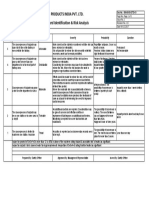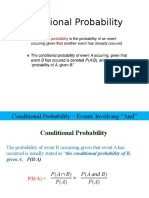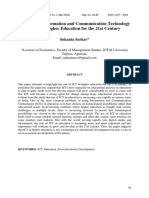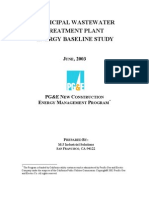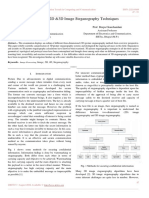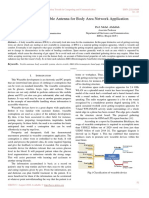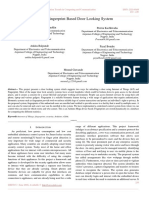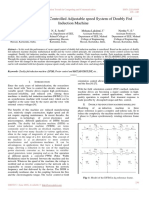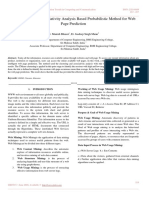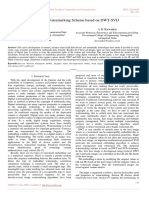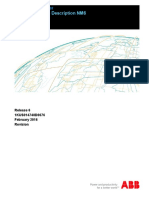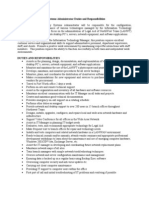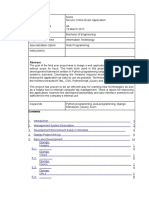Rainfall Prediction Based On Rainfall Statistical Data
Uploaded by
Editor IJRITCCRainfall Prediction Based On Rainfall Statistical Data
Uploaded by
Editor IJRITCCInternational Journal on Recent and Innovation Trends in Computing and Communication
Volume: 4 Issue: 3
ISSN: 2321-8169
270 - 275
_______________________________________________________________________________________
Rainfall Prediction based on Rainfall Statistical Data
Dr. Dayanand. G. Savakar
Dr. Anami.B.S
Dr. Venkatesh
R. R. Rohidekar
Associate Professor
Department of Computer Science.
Post Graduate Centre,Vachana
Sangama,
Rani Channamma UniversityToravi,
Vijaypur-586108,Karnataka,India
KLE IT Hubli
India
Agrometeorologist
UAS Bijapur.Karnataka
BLDEA,s Engg
India
Abstract: The paper describes the development of a system to provide information on rainfall characteristics of rainfall and its prediction from
the historical data sets, and selection of crops based on the forecast on taluka basis, with a case study of Bijapur district of Karnataka State,
India. The analysis of rainfall viz. month wise, Nakshatra-wise, week-wise and year-wise is carried out. The developed system, evolved from the
analysis of 20 years rainfall data collected from the Agricultural Research Station, Bijapur is very useful to agrometeorologists. The
performance of the prediction system is encouraging and the accuracy of the prediction varies between 80% and 90%.
_________________________________________*****_________________________________________
INTRODUCTION
1.0 THE PROPOSED SYSTEM
Rainfall is the most important climate variable that
affects the crops in the tropical rain fed regions. People
wish to know whether there would be rainfall in the coming
months or year. To fulfill this requirement, one needs a
forecast, well ahead of the commencement of the crop
season. Such rainfall forecasts can be used both by the
farmers and the Government in planning for the ensuing
year. This work is an attempt to analyze the available data
for development of a system for rainfall forecast and crop
selection, from taluka level to state level. This work thus
introduces a novel concept called region bound model for
Rainfall prediction.
Rainfall is known to follow set patterns that can be
explained by statistical and mathematical procedures like
trend, periodicity and serial correlation. Hence it would be
possible to develop appropriate models for long range
forecast of rainfall. However, rainfall patterns vary within a
country and within a state, in view of its high variability
both temporally and spatially. We are aware, that the long
range forecasts issued by the India Meteorological
Department need considerable downscaling for appropriate
agricultural applications. On the other hand models using
the historical rainfall patterns in individual sub-regions like
taluka or district can be up-scaled up to a larger area like a
state or a country. This proposed model uses local
speculation to global speculation approach (this, we call
incremental approach). The forecast of rainfall for
individual talukas of a particular district will help in guiding
the district
The proposed system is divided into five modules,
namely: Administrator Module, Rainfall data entry Module,
Predictor Module, Comparator Module and Crop Selection
Module (Figure 2).
country
District
Taluka
Village
Proposed Method
Existing method
state
Rainfall
data Entry
Module
Comparator
Module
Administrator
Module
Crop
selection
Module
Predictor
Module
Figure 2: Functional Diagram of the proposed system
2.1 Administrator Module
This module provides the security for the data and deals
with the granting of permission and revoking of users, and
therefore is the vital part of the system. The administrator
module takes care of user accounts, facilitates updating data,
editions to crop lists, the cities and the addresses. Granting
permissions to users involves the user name and the
password information, which are supplied by the system
administrator. Modifying of account is also done by the
system administrator.
Figure 1: Incremental Model
270
IJRITCC | March 2016, Available @ http://www.ijritcc.org
_______________________________________________________________________________________
International Journal on Recent and Innovation Trends in Computing and Communication
Volume: 4 Issue: 3
ISSN: 2321-8169
270 - 275
_______________________________________________________________________________________
2.2 Rainfall Entry Module
The Rainfall data entries are divided into four different
categories, namely, Monthly Rainfall, Nakshatra Rainfall,
Weekly rainfall and Daily Rainfall. The entries can be made
as per data availability; if daily data are entered, the data for
other periods will be computed as required. Interactions in
this module are given in Figure 3.
Daily Rainfall
Data
Daily rainfall
data
Rainfall database
Rainfall Data
Conversion
Rainfall data
Reports
Figure 3: Rainfall data Entry Module
2.3 Predictor Module
This module uses the algorithms for the processes
involving trend, serial correlation, harmonic components
and autoregression analysis as mentioned earlier with
appropriate reference to Aggarwal (1992), to forecast
monthly, Nakshatra-period and weekly rainfall. The
database of the particular month or Nakshatra is accessed,
and the data are converted into vectors. The prediction is
done by using these vectors, which are input to the
algorithms. These vectors are stored into a temporary
database to generate reports such as graphs, charts etc. The
details of the predictor module are given in Figure 4 and
detailed process is given in Algorithm 1.
Monthly rainfall
database
Nakshatra
rainfall database
Monthly
rainfall data
may be termed as mean annual rainfall, or the normal.
Comparison of the annual rainfall of a selected year is made
with the normal. The result is stored and displayed as per the
users requirement, as a report or graph.
b) months to months
In this method of prediction, three parameters are used
namely, from-year, to- year and month. It extracts the data
from the monthly rainfall database for a specified month to
calculate the normal for the month. Comparison of rainfall
in the month of any year is done with the normal.
c) week to week
In this method, weekly analysis is done in place of the
monthly, mentioned above. Weekly normals are calculated
and data of any year is compared with it.
d) Nakshatra to Nakshatra
In this comparison, three parameters are supplied they
are from-year, to- year and the Nakshatra. This is similar to
the above two, except that the procedure is for Nakshatra
period. Comparison of rainfall is done for that particular
Nakshatra period with the normal for the same Nakshatra
period computed from the database.
e) Actual vs. Forecast
The data of estimated/forecast of rainfall and actual
rainfall are extracted form the database for a given year and
comparison is made. The various types of reports are
generated such as Graph, charts etc. The aforesaid activities
are depicted in Figure 5 and detailed process is depicted in
Algorithm 2.
User Input
Rainfall
database
Weekly rainfall
database
Nakshatra
rainfall
data
Weekly
rainfall data
Rainfall
Predictor
Reports
Graphs and Reports
Finding
Trends in
rainfall
Range of
years
Year1 and
Year 2
Rainfall
data
Rainfall
estimation
Reports
Rainfall
data
Graphs and
Reports
Figure 4: Predictor Module
2.4 Comparator Module
The comparator module uses the rainfall forecast and
compares with the actual rainfall in a given year, i.e. year to
year, month to month, week to week and Nakshatra to
Nakshatra, as required by the user.
a) Year_ to_ year
This comparison takes two parameters as inputs namely,
from-year and to-year. It calculates the sum of all the
months rainfall data from-year to to-year using monthly
database. Finally, the average of this sum is calculated. This
Figure 5: Comparator Module
3.0 THE ALGORITHMS
The modules are presented as different algorithms in this
section. The functionality of the modules and the important
operations are brought out.
Algorithm 1: Rainfall prediction
Inputs: Rainfall data.
Output: Forecasted Rainfall
Start
Step 1: Accept rainfall data from the rainfall database
Step 2: Calculate average rainfall from the rainfall data
271
IJRITCC | March 2016, Available @ http://www.ijritcc.org
_______________________________________________________________________________________
International Journal on Recent and Innovation Trends in Computing and Communication
Volume: 4 Issue: 3
ISSN: 2321-8169
270 - 275
_______________________________________________________________________________________
Step 3: Repeat Steps (3.1 to 3.4) for requested periods
Step3.1: Estimate rainfall using Linear trend
Step3.2: If (Estimated rainfall (Average rainfall + 10%
Average rainfall))
then
Rainfall status = Above Normal
Step3.3: If (Estimated rainfall (Average rainfall - 10%
Average rainfall))
then
Rainfall status = Below Normal
Step3.4: If (Estimated rainfall lies between above and
below normal limit)
then
Rainfall status = Normal
Step 4: Display the Rainfall status.
Stop
a) Algorithm 1: Monthly Rainfall Prediction
The monthly rainfall prediction algorithm forecasts the
monthly rainfall, by the history of monthly rainfall data
from the rainfall database. It forecasts monthly rainfall of
the given year and also the subsequent years.
Box 4: Nakshatra Based Prediction for the Year 2004
Box 1: Monthy Rainfall Prediction for the Year 2004
c) Weekly Rainfall Prediction
The weekly rainfall prediction section forecasts the
future weekly rainfall. By extracting historical weekly
rainfall data from the database, it forecasts weekly rainfall
of the present year and next year.
Box 2: Monthly Rainfall Prediction for the Year 2004
Box 5: Weekly Rainfall Prediction for the Year 2004
b) Nakshatra Rainfall Prediction
The Nakshatra rainfall prediction involves history of
Nakshatra rainfall and forecasts rainfall of the present year
and also next year.
Box 3: Nakshatra Based Prediction for the Year 2004
272
IJRITCC | March 2016, Available @ http://www.ijritcc.org
_______________________________________________________________________________________
International Journal on Recent and Innovation Trends in Computing and Communication
Volume: 4 Issue: 3
ISSN: 2321-8169
270 - 275
_______________________________________________________________________________________
Box 8: Seasonal Rainfall Prediction for the Year 2004
Box 6: Weekly Rainfall Prediction for the Year 2004
d) Seasonal Rainfall Prediction
The seasonal rainfall predicts future seasonal rainfall. By
the history of monthly rainfall data, it forecasts seasonal
rainfall of the present year and also next year. One can
specify the group of months as a season to the system.
Algorithm 2: Rainfall Comparison
Input: Rainfall database
Output: Rainfall comparison
Start
Step 1: Accept the period for which data to be compared.
Step 2: Get rainfall data from the relevant database for a
specified period.
Step 3: Compare the rainfall status for a given period.
Step 4: Display rainfall status as a report.
Stop
e) Yearly Rainfall comparison
The yearly rainfall is used for the analysis of annual
rainfall. By the history of monthly rainfall data annual
rainfall is calculated.
Box 7: Seasonal Rainfall Prediction
Box 9: Comparison of Actual Rainfall Prediction
from the 2001 to 2002
273
IJRITCC | March 2016, Available @ http://www.ijritcc.org
_______________________________________________________________________________________
International Journal on Recent and Innovation Trends in Computing and Communication
Volume: 4 Issue: 3
ISSN: 2321-8169
270 - 275
_______________________________________________________________________________________
Box 10: Comparison of Actual Rainfall from 2001 to
2002
f) Monthly Rainfall comparison
The monthly rainfall comparison section gives
comparative analysis of month wise rainfall. By extracting
historical monthly rainfall data from the database
comparison is done.
Box 13: Comparison of Actual Rainfall for the
Nakshatra Punarvasu with Previous Year
Box 14: Graphical Comparison of Actual Rainfall
with Previous Year for the Nakshatra Punarvasu
Box 11: Comparison of Actual Rainfall with Normal
for the Month of June
Box 12: Graphical Presentation Actual Rainfall for June
g) Nakshatra Rainfall comparison
The Nakshatra based rainfall gives comparative analysis
of the Rain. By history of Nakshatra rainfall data is stored
for the database.
Algorithm 3: Actual v/s Forecast Rainfall Comparison
Input: Monthly Rainfall data
Output: Forecast Vs Actual Rainfall Comparison
Start
Step 1: Get monthly rainfall data available
Step 2: Calculate Average Rainfall for all the months in
a year
Step 3: Accept the year from user
Step 4: Calculate Average Rainfall of the given month
Step 5: Calculate estimated Rainfall for 12 months
Step 6: Display Monthly Rainfall data, Average Rainfall
data and Estimated Rainfall
Stop
h) Forecast vs Actual Rainfall Comparison
The forecast vs actual rainfall comparison section gives
comparative analysis forecasted rainfall and actual rainfall.
By extracting historical monthly rainfall data from the
database comparison is done.
Box 15: Forecasted Vs Actual Rainfall for the Year 2002
274
IJRITCC | March 2016, Available @ http://www.ijritcc.org
_______________________________________________________________________________________
International Journal on Recent and Innovation Trends in Computing and Communication
Volume: 4 Issue: 3
ISSN: 2321-8169
270 - 275
_______________________________________________________________________________________
[5]
[6]
[7]
during 1871-1978, Climatic change, Vol. 6, pp
287-301.
Rupa Kumar K, Pant G.B, Parthsa.rathy B. and
Sontakke N A (1992) Spatial and sub seasonal
patterns of long term trends of Indian summer
monsoon rainfall. International Journal of
climatology, Vol. 12, pp 257-268 .
Shukla, P.R., Sharma Subodh K, Venkata Ramana
P (2002) Climate Change and India: Issues,
Concerns and Opportunities. Publishers: TATA
McGraw-Hill, New Delhi.
Venkatesh H (2004) Rainfall analysis as a tool in
watershed development in northern dry zone of
Karnataka.
Publishers:
Publication Centre,
University of Agricultural ScieSnces, Dharwad.
Box 16: Graphical comparison of Forecast and
Actual Rainfall for the Year 2002
3.0. CONCLUSION
A methodology for analyzing the historical rainfall data
of monthly and Nakshatra periods is developed for their
long range forecast one season ahead. This system is useful
for not only for forecasting, but also for analytical
comparison with the past data. Regional data is used in the
analysis, which is considered to be a novel approach for
forecast and up-scaling to state level.
REFERENCES:
[1]
[2]
[3]
[4]
Agarwal A. (1999) Stochastic model of monthly
rainfall for Nainital, Journal of Agricultural
Engineering, Vol. 25 (3), pp 20-31
.Cannon Alex J. and Mckendry Ian G., (1999)
Forecasting all India summer monsoon rainfall
using regional circulation principle components: A
comparison between neural network and multiple
regression models, Journal of Climatology, Vol.
19(4), PP-1561-1578.
Cannon Alex J. and Mckendry Ian G., (2002) A
graphical sensitivity analysis for statistical climate
models: Application to Indian monsoon rainfall
prediction by Artificial Neural Networks and
Multiple Linear Regression models, Journal of
Climatology, Vol. 22, pp1687-1708.
Mooley D.A and Parthsarathy B. (1984),
Fluctuations of all India summer monsoon rainfall
275
IJRITCC | March 2016, Available @ http://www.ijritcc.org
_______________________________________________________________________________________


















